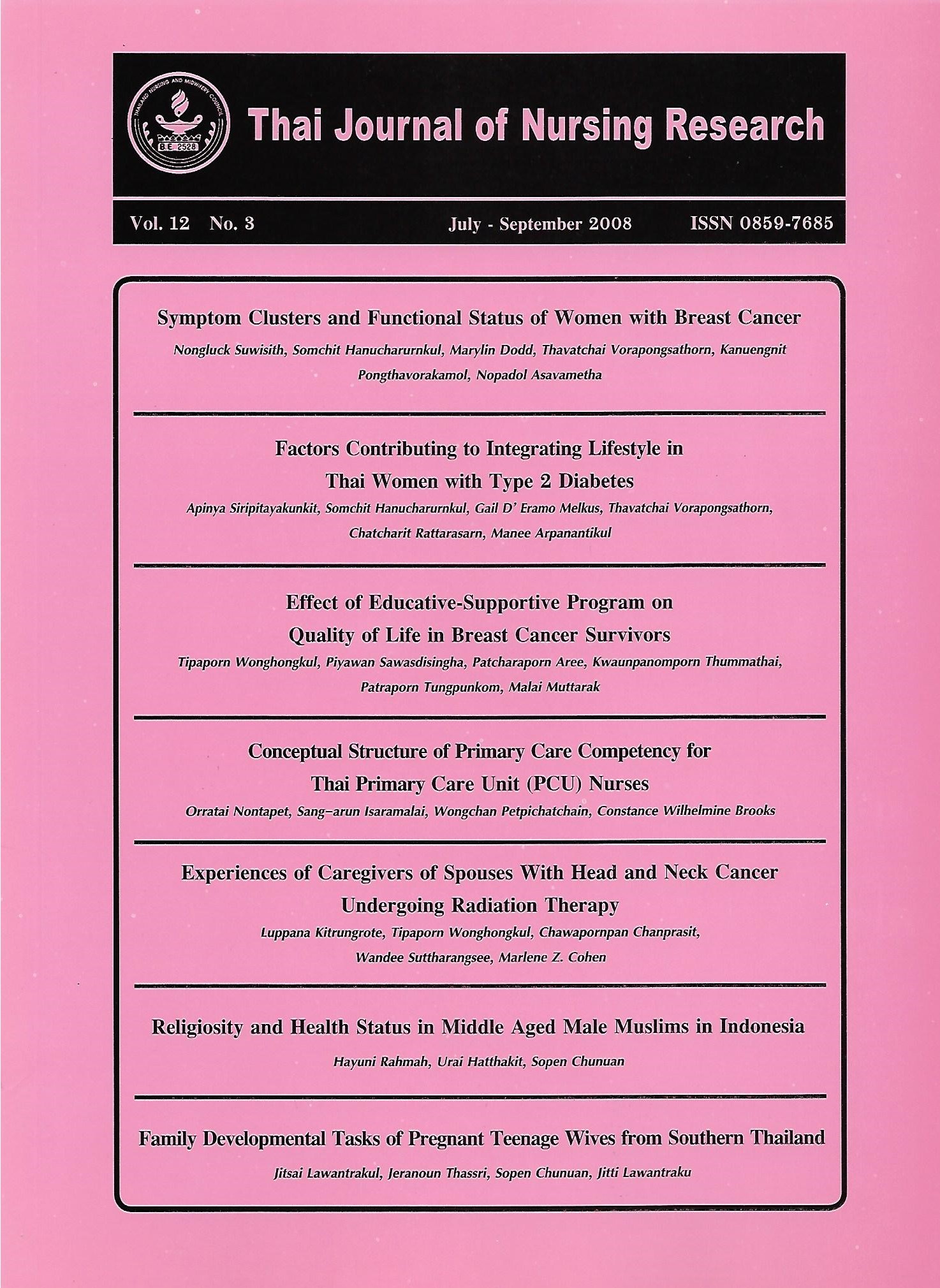Symptom Clusters and Functional Status of Women with Breast Cancer
Keywords:
มะเร็งเต้านม, เคมีบำบัด, การวิเคราะห์ปัจจัย, ความสามารถในการทำกิจกรรม, กลุ่มอาการAbstract
บทคัดย่อ
การวิจัยนี้มีวัตถุประสงค์เพื่อศึกษากลุ่มอาการ และอิทธิพลของกลุ่มอาการต่อความสามารถ ในการทำกิจกรรมของผู้ป่วยเป็นมะเร็งเต้านม กลุ่มตัวอย่างจำนวน 320 คนเป็นหญิงไทยที่ป่วยเป็นมะเร็งเต้านมและอยู่ในระหว่างการรักษาด้วยยาเคมีบำบัด คัดเลือกโดยการสุ่มแบบเจาะจง วิเคราะห์ข้อมูลโดยใช้สถิติการวิเคราะห์ปัจจัย และการวิเคราะห์ความถดถอยเชิงพหุ
ผลการวิเคราะห์พบว่ากลุ่มอาการของความรุนแรงและกลุ่มอาการของความทุกข์ทรมานมีความแตกต่างกัน ในการวิเคราะห์จัดกลุ่ม สามารถจำแนกกลุ่มอาการด้านความรุนแรงออกเป็น 4 กลุ่ม อธิบายความแปรปรวนของอาการทั้งหมดได้ร้อยละ 50.1 คือกลุ่มอาการทางอารมณ์ กลุ่มอาการด้านทางเดินอาหารและอาการอ่อนล้า กลุ่มอาการด้านภาพลักษณ์และการเปลี่ยนแปลงผิวหนัง และกลุ่มอาการด้านความเจ็บปวดและความไม่สุขสบาย ทั้ง 4 กลุ่มอาการมีอิทธิพลอย่างมีนัยสำคัญทางสถิติ (p<0.05) คิดเป็นร้อยละ 19.8 ของความแปรปรวนทั้งหมดของความสามารถในการทำกิจกรรม กลุ่มอาการด้านความทุกข์ทรมานจำแนกออกเป็น 3 กลุ่ม อธิบายความแปรปรวนของอาการทั้งหมดได้ร้อยละ 50.7 คือกลุ่มอาการด้านอารมณ์และความเจ็บปวด กลุ่มอาการด้านทางเดินอาหารและอาการอ่อนล้า กลุ่มอาการด้านภาพลักษณ์และการเปลี่ยนแปลงผิวหนัง ทั้ง 3 กลุ่มอาการมีอิทธิพลอย่างมีนัยสำคัญทางสถิติ (p<0.05) คิดเป็นร้อยละ 17.4 ของความแปรปรวนทั้งหมดของความสามารถในการ ทำกิจกรรม กลุ่มอาการทางเดินอาหารและอาการอ่อนล้า เป็นกลุ่มอาการที่มีอิทธิพลต่อความสามารถ ในการทำกิจกรรมมากที่สุดทั้งในด้านความรุนแรงของอาการและความทุกข์ทรมานจากอาการ
คำสำคัญ: มะเร็งเต้านม เคมีบำบัด การวิเคราะห์ปัจจัย ความสามารถในการทำกิจกรรม กลุ่มอาการ
Abstract
This study aimed to explore symptom clusters across two symptom dimensions and their influences on functional status of women with breast cancer. Sample consisted of 320 Thai women diagnosed with breast cancer undergoing chemotherapy. They were purposively selected and evaluated for their symptom experiences and functional status. Factor analysis and multiple regression were used to examine symptom clusters and their significant effects on the functional status of the women.
Symptom clusters existed across the two symptom dimensions. Symptom clusters of symptom severity and those of symptom distress were not identical. Four symptom clusters existed in the dimension of symptom severity, with 50.1% variance explained in all the symptoms. The clusters were emotions related symptoms, GI and fatigue related symptoms, image related cutaneous symptoms, and pain related discomfort symptoms. The clusters significantly explained 19.8% of the variance in the functional status (p<0.05). Three symptom clusters were identified in the dimension of symptom distress, with 50.7% variance in all the symptoms. They were the clusters of emotions and pain related discomfort symptoms, GI and fatigue related symptoms, and image related cutaneous symptoms. The clusters significantly explained about 17.4% of variance in the functional status (p<0.05). GI and fatigue related symptom cluster was the strongest predictor cluster affecting the functional status in both dimensions of symptom severity and symptom distress.
Keywords: breast cancer, chemotherapy, factor analysis, functional status, symptom clusters
Downloads
How to Cite
Issue
Section
License
Copyright: The Pacific Rim International Journal of Nursing Research, Thailand Nursing & Midwifery Council has exclusive rights to publish, reproduce and distribute the manuscript and all contents therein.








.png)



